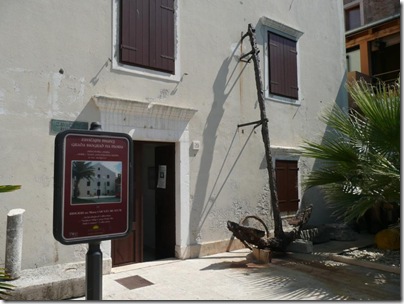Croatia’s Undiscovered Treasures In The City Museum In Biograd
Tucked away a little, just opposite Biograd’s ferry terminal is Croatia’s lovely City Museum. We first discovered it back in late 2006 when we were lucky enough to bump into Mirko Čekop, an archaeologist, who gave us the full story behind the Gnalić wreck. Below, in italics, is the original write up we did for the second edition (2007) of Time Out’s Visitors Guide to Croatia.
We looked up Mirko again a couple of weeks ago to get an update. Mirko tells us that, eventually, the glass from the Gnalić wreck will have its own museum in Biograd. This could take as long as five years but the plan is to build a museum near where the existing bus station is and move the bus station a little out of town to ease congestion. The current City Museum will be housed there too – it currently occupies one of the oldest buildings on the Riva, an 18th century building that was first used as a courthouse. Unfortunately the building is now too small to display anything but a small part of the treasures and many of them remain in store.
As you might expect, Mirko is a mine of information on many things and told us about the latest discoveries in Biograd, the most important of which is the excavation that took place around the Basilika area of the centre. The excavation was completed in 2008 and though the material is still being identified, there were some fascinating discoveries of 10th and 11th century life when Biograd enjoyed its heyday as a grand city that challenged Zadar and Split. The area has now become a city square with the remains of the site covered with stone slabs. There’s also a good new restaurant, Basilika, nearby which serves up dishes that are a little bit different from Dalmatia’s normal offering.
We couldn’t write fast enough to note down all the fascinating information that Mirko imparted to us but here are some interesting facts about Biograd and related matters.
1. The Monastery of St John reveals the first use of money in Croatia
2. Biograd’s current name derives from the word white, in local dialect “Bilo” – the same deriviation as Beograd in Serbia. However, until 1921, Biograd was called Zaravechia which means “old Zadar”. Apparently, when it was discovered in ruins following destruction by the Venetians in 1125 and again in the retreat from the Turks in 1646, it was assumed that nearby Zadar had been reconstructed in its place.
3. Latin, as opposed to Slavic influence on the Croatian language is apparently most evident in building and nautical vocabulary. Of the hundreds of words in everyday use amongst sailors and fisherman, it appears that only three have a Slavic origion - “brod” (boat), “jadro” (sail) and “cesta” (road), the latter we assume receiving a wider, land based, use later. Mirko also told us that the last Croatian using Latin as their mother tongue died, as recently as the end of the 19th century, on the island of Krk.
As for the Gnalić wreck, since our original report the glass has all been analysed and you can read more about that by following this link to the Sheffield University website.
As ever, many thanks to Mirko for his time and enthusiasm in bringing the region’s history to life for us.
Zavičajni Muzej (Regional Museum)
Krešimirova Obala 22(023 383 721). Open Summer 9am-noon, 8pm-11pm; winter 7am-2pm Mon-Sat. Admission 10 kn.
The rusting anchor outside the sea front premises signals some of the quirky delights inside. A collection of urns and bowls from roman and other eras warms you up for the story of Biograd, told in a collection of pictures, relics and reconstructions. The highlight is upstairs – parts of a 16th century Venetian galley-ship sunk off the islet of Gnalić, south of Biograd in the entrance to the Pašman Canal. The ship was discovered in 1967 along with some of its treasures which include glassware, ceramics and textiles. Over 5,500 items of glassware were recovered, in the course of 6 diving operations, the last one in 1996, making it the largest collection of post Roman glass ever found from a single source. Only a small part of the glassware is currently on display here and most of it may end up in a purpose built museum in Zadar. It’s probably Murano glass but in 2005 a team of English and Slovene archaeologists undertook the first systematic analysis of it and, at the time of writing, ON Books were about to publish their findings - “Glass from the Gnalić Wreck” by Dr Hugh Willmott, Dr Caroline Jackson (University of Sheffield) & Dr Irena Lazar (University Primorska, Koper). The museum can be a little short of information in English but grab one of the helpful members of staff for a one to one tour if you can. The story of the wreck and its recovery is fascinating.


0 Comments:
Post a Comment
<< Home